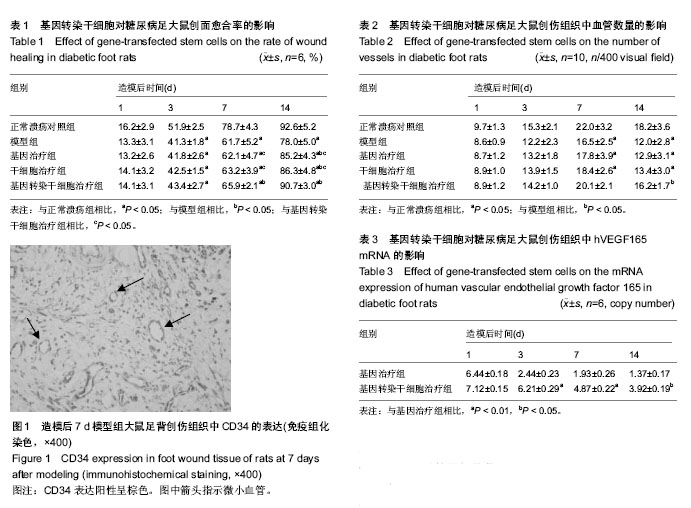| [1] Szabad G. Diabetic foot syndrome. Orv Hetil. 2011;152(29): 1171-1177.
[2] Apelqvist J, Larsson J. What is the most effective way to reduce incidence of amputation in the diabetic foot? Diabetes Metab Res Rev. 2000;16 Suppl 1:S75-83.
[3] Bowering CK. Diabetic foot ulcers. Pathophysiology, assessment, and therapy. Can Fam Physician. 2001;47: 1007-1016.
[4] Richbourg MJ. Whatever happened to foot care? Preventing amputations in patients with end stage renal disease. Edtna Erca J.1998;24(4):4-10.
[5] Muha J. Local wound care in diabetic foot complications. Aggressive risk management and ulcer treatment to avoid amputation. Postgrad Med. 1999;106(1):97-102.
[6] Maxson S, Lopez EA, Yoo D, et al. Concise review: role of mesenchymal stem cells in wound repair. Stem Cells Transl Med. 2012;1(2):142-149.
[7] Li H, Fu X. Mechanisms of action of mesenchymal stem cells in cutaneous wound repair and regeneration. Cell Tissue Res. 2012;348(3):371-377.
[8] Hocking AM, Gibran NS. Mesenchymal stem cells: paracrine signaling and differentiation during cutaneous wound repair. Exp Cell Res. 2010;316(14):2213-2219.
[9] Fu X, Li H. Mesenchymal stem cells and skin wound repair and regeneration: possibilities and questions. Cell Tissue Res. 2009;335(2):317-321.
[10] Phinney DG, Prockop DJ. Concise review: mesenchymal stem/multipotent stromal cells: the state of transdifferentiation and modes of tissue repair--current views. Stem Cells. 2007; 25(11):2896-2902.
[11] Kim HA, Lim S, Moon HH, et al. Hypoxia-inducible vascular endothelial growth factor gene therapy using the oxygen-dependent degradation domain in myocardial ischemia. Pharm Res. 2010;27(10):2075-2084.
[12] Alavi A, Sibbald RG, Mayer D, et al. Diabetic foot ulcers: Part I. Pathophysiology and prevention. J Am Acad Dermatol. 2014; 70(1):1.e1-18; quiz 19-20.
[13] Apelqvist J, Bergqvist D, Eneroth M, et al. The diabetic foot. Optimal prevention and treatment can halve the risk of amputation. Lakartidningen. 1999;96(1-2):37-41.
[14] van Dam PS, Valk GD, Bakker K. Diabetic peripheral neuropathy: international guidelines for prevention, diagnosis, and treatment. Ned Tijdschr Geneeskd. 2000;144(9):418-421.
[15] Schaper NC, Andros G, Apelqvist J, et al. Diagnosis and treatment of peripheral arterial disease in diabetic patients with a foot ulcer. A progress report of the International Working Group on the Diabetic Foot. Diabetes Metab Res Rev. 2012;28 Suppl 1:218-224.
[16] O'Loughlin A, McIntosh C, Dinneen SF, et al. Review paper: basic concepts to novel therapies: a review of the diabetic foot. Int J Low Extrem Wounds. 2010;9(2):90-102.
[17] Goodridge D, Trepman E, Embil JM. Health-related quality of life in diabetic patients with foot ulcers: literature review. J Wound Ostomy Continence Nurs. 2005;32(6):368-377.
[18] Liang W, Cai Q, Liu Y. Transfection of human vascular endothelial growth factor 165 gene into rat bone marrow mesenchymal stem cells in vitro. Zhongguo Xiu Fu Chong Jian Wai Ke Za Zhi. 2011;25(11):1383-1388.
[19] Kuo YR, Wang CT, Cheng JT, et al. Bone marrow-derived mesenchymal stem cells enhanced diabetic wound healing through recruitment of tissue regeneration in a rat model of streptozotocin-induced diabetes. Plast Reconstr Surg. 2011; 128(4):872-880.
[20] Livak KJ, Schmittgen TD. Analysis of relative gene expression data using real-time quantitative PCR and the 2(-Delta Delta C(T)) Method. Methods. 2001;25(4):402-408.
[21] Blumberg SN, Berger A, Hwang L, et al. The role of stem cells in the treatment of diabetic foot ulcers. Diabetes Res Clin Pract. 2012;96(1):1-9.
[22] Apelqvist J, Bakker K, van Houtum WH, et al. Practical guidelines on the management and prevention of the diabetic foot: based upon the International Consensus on the Diabetic Foot (2007) Prepared by the International Working Group on the Diabetic Foot. Diabetes Metab Res Rev. 2008;24 Suppl 1:S181-187.
[23] Apelqvist J, Bakker K, van Houtum WH, et al. International consensus and practical guidelines on the management and the prevention of the diabetic foot. International Working Group on the Diabetic Foot. Diabetes Metab Res Rev. 2000; 16 Suppl 1:S84-92.
[24] Bakker K, Schaper NC; International Working Group on Diabetic Foot Editorial Board. The development of global consensus guidelines on the management and prevention of the diabetic foot 2011. Diabetes Metab Res Rev. 2012;28 Suppl 1:116-118.
[25] Jirkovská A. Adherence to the international guidelines on the treatment of diabetic leg syndrome--options available in the Czech Republic. Vnitr Lek. 2011;57(11):908-912.
[26] Helfand AE. Assessing and preventing foot problems in older patients who have diabetes mellitus. Clin Podiatr Med Surg. 2003;20(3):573-582.
[27] Kwon MJ, An S, Choi S, et al. Effective healing of diabetic skin wounds by using nonviral gene therapy based on minicircle vascular endothelial growth factor DNA and a cationic dendrimer. J Gene Med. 2012;14(4):272-278.
[28] Wu Y, Chen L, Scott PG, et al. Mesenchymal stem cells enhance wound healing through differentiation and angiogenesis. Stem Cells. 2007;25(10):2648-2659.
[29] Wu Y, Wang J, Scott PG, et al. Bone marrow-derived stem cells in wound healing: a review. Wound Repair Regen. 2007;15 Suppl 1:S18-26. |

.jpg)